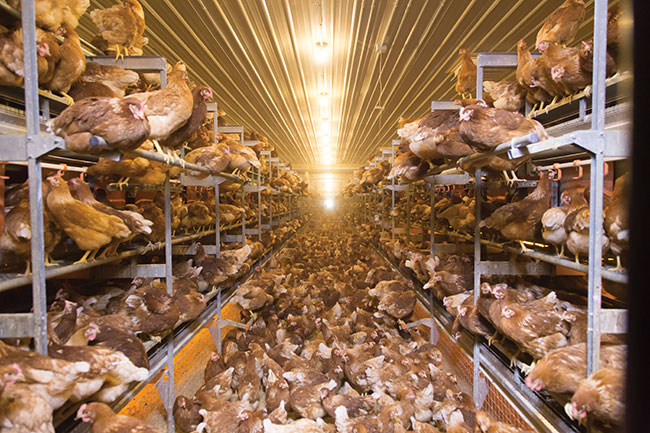
Air quality management in cage-free housing
By Erika Prewitt
Features Barn ManagementPoor air quality in a cage-free house affects not only the birds but also the workers. Here are eight tips to help improve air quality.
 Poor air quality in a cage-free house effects not only the birds but also the workers.
Photo: Big Dutchman
Poor air quality in a cage-free house effects not only the birds but also the workers.
Photo: Big Dutchman Poor air quality in a cage-free house affects not only the birds but also the workers. Neither people nor birds enjoy being in a house with strong smells, hot temperatures, wet litter or dusty conditions.
You may find it harder to employ workers to work in these types of barns. From the hen side, we can see reduced production, bird health and egg quality.
Typically, we see poor air quality being an issue more in the layer houses than in the pullet houses. But none the less, dusty, smelly, and stale air can happen in any barn. Here are eight tips to help improve air quality.
1. Air movement
Having enough fans that are properly running is key to good ventilation. Stale air can cause uncomfortable living conditions for the hens. We will see them seeking out areas that do have air movement to lay. These areas can then become very crowded and have high numbers of both system and floor eggs.
2. Temperature setting
Cooler temperatures will allow you to move more air through the house. Not only that, it is more comfortable for the workers and for the hens.
3. High ammonia smell
One of the first signs of poor air quality when walking into a barn can be the overwhelming foul smell of ammonia. It is important to implement some kind of litter reduction system within the house to make sure you aren’t getting a building up of litter.
4. Preventing scattering
Avoid fast movements and loud sudden noises to prevent birds from becoming scared and scattering and creating excessive dust.
5. Wet litter
Wet spots should be cleaned up and replaced with dry litter. Wet areas can be due to leaks or cool cells in the front of house. Try your best to keep litter dry. You may have to remove wet litter in the aisle manually throughout the flock. You can either add shavings then to help absorb the moisture or you can use dry litter located in other places within the aisle to act as a base to encourage dry litter.
6. Tunnel ventilation
Tunnel ventilation is not always the number one choice for cage-free housing. However, it can improve air quality by consistently moving a large amount of air evenly.
7. Stir fans
Stir fans can help create more even air flow and temperature through the house and in-between levels of the house.
8. Calm birds
Calm birds can help reduce the stirring up of dust. Ideally, you should be able to see the back of the house when standing in the front.
Birds should be walked frequently during rearing to expose them to human interaction and help avoid flightiness when moved to the laying facility.
The main goals with creating proper air quality within a cage-free house is to have proper ventilation, overall consistent air movement, remove any wet areas of litter, and to keep the birds from causing too much dust. By doing these things, you are making the environment both better for the birds and the workers.
Poor air quality can ruin a newly built barn. Take the time to research the needed amount of fans and power of the fans to properly ventilate your barn.
Remember to even take into consideration the design of the system that will be in the barn, as this can restrict air flow.
Aisle width between rows of the equipment can cause an increase in wet litter also. Try to make your aisle widths as wide as feasible. Narrow aisles are not ideal for bird welfare or litter management.
Erika Prewitt is aviary systems specialist with Big Dutchman. In this column, she shares cage-free management tips for egg producers.
Print this page